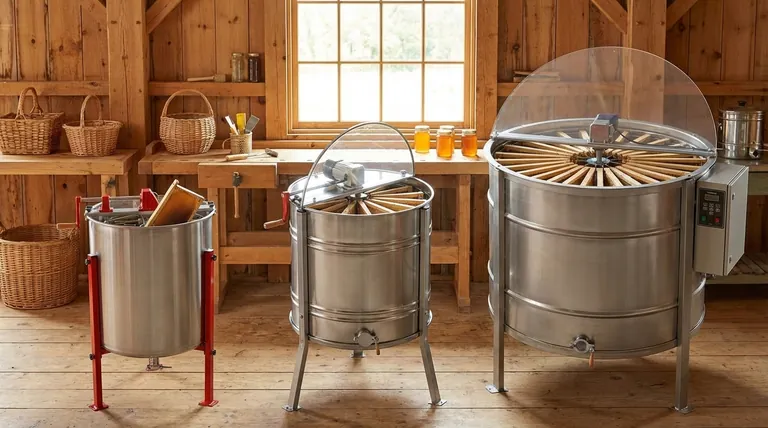At a glance, a honey extractor's frame capacity varies dramatically by type. Small manual extractors typically hold between 2 to 8 frames, tangential models hold 3 to 6 frames, and large-scale radial extractors can hold anywhere from 4 to over 100 frames at a time.
The number of frames an extractor can hold is a direct reflection of its underlying design. This design—primarily whether it is radial or tangential—dictates the speed, efficiency, and scale of your honey harvesting operation.

The Core Extractor Types and Their Capacities
Understanding frame capacity begins with understanding the three primary categories of extractors available to beekeepers. Each is designed for a different scale and level of investment.
Manual Extractors: The Hobbyist's Starting Point
Manual extractors are powered by a hand crank and are the most common entry point for new beekeepers due to their simplicity and lower cost.
Their capacity is generally limited, typically holding between 2 and 8 frames.
Tangential Extractors: The One-Sided Method
In a tangential design, the frames are placed with one side of the honeycomb facing the outer wall of the extractor drum.
These models, which can be manual or motorized, usually hold between 3 and 6 frames. Their key operational feature is that you must stop the process and manually flip each frame to extract the honey from the other side.
Radial Extractors: The Commercial Standard
Radial extractors are the workhorses of larger operations. Frames are positioned vertically, like the spokes of a wheel, with the top bar facing outwards.
This design allows them to hold a vast range of frames, from 4 in smaller models to over 100 in commercial units. They are almost always motorized.
How Extractor Design Dictates Efficiency
The difference between holding 4 frames and 40 frames isn't just about size; it's about the physics of the extraction process. The efficiency gains come from how the extractor uses centrifugal force.
The Tangential Flip: Slower but Thorough
Because only one side of the comb faces outward at a time, tangential extractors require you to extract honey in two steps.
This process of spinning, stopping, flipping, and spinning again adds significant time and labor, making it suitable for small harvests where speed is not the primary concern.
The Radial Spin: Built for Speed and Scale
The "spokes on a wheel" configuration of a radial extractor is its key advantage. As the drum spins, centrifugal force pulls honey out of the cells on both sides of the frame simultaneously.
This fundamental design difference is what enables efficient, large-scale honey processing and allows radial extractors to be built with such high capacities.
Understanding the Trade-offs
Choosing an extractor is a balance of cost, labor, and the scale of your apiary. A larger capacity is not always the better choice if it doesn't align with your needs.
Cost vs. Capacity
The correlation is direct and predictable. A simple 2-frame manual extractor has the lowest upfront cost, while a 100-frame motorized radial extractor represents a major financial investment.
Labor vs. Automation
A manual extractor requires constant physical effort. Flipping frames in a tangential model adds more steps and handling time.
A motorized radial extractor dramatically reduces the physical workload, freeing you to uncap the next batch of frames while the machine works.
Frame Size Compatibility
An extractor's stated capacity doesn't mean it will fit your specific equipment. Always verify that the model you are considering is compatible with the frame sizes you use, whether they are deep, medium, or shallow.
Making the Right Choice for Your Apiary
Your decision should be based on the current size of your apiary and your goals for the future.
- If you are a beginner with 1-3 hives: A 2-4 frame manual extractor is the most cost-effective and practical choice for learning the process.
- If you are a growing hobbyist with 4-10 hives: An electric extractor, either a larger tangential or a small radial model, will save you a significant amount of time and effort during the harvest.
- If you are a sideliner or commercial beekeeper: A large-capacity, electric radial extractor is the only practical option for processing your harvest efficiently.
Ultimately, choosing the right extractor is an investment in your time and the future success of your beekeeping.
Summary Table:
| Extractor Type | Typical Frame Capacity | Best For |
|---|---|---|
| Manual | 2 - 8 frames | Beginners (1-3 hives) |
| Tangential | 3 - 6 frames | Hobbyists (small harvests) |
| Radial | 4 - 100+ frames | Commercial/Sideliner beekeepers |
Ready to Scale Your Honey Harvesting?
Choosing the right extractor is crucial for your operation's efficiency and growth. At HONESTBEE, we specialize in supplying commercial apiaries and beekeeping equipment distributors with high-capacity, durable honey extractors and other essential beekeeping supplies through our wholesale-focused operations.
Let us help you invest in equipment that saves time, reduces labor, and maximizes your harvest. Contact our expert team today to discuss the best extractor solution for your needs!
Visual Guide

Related Products
- 6 Frame Manual Stainless Steel Honey Extractor Beekeeping Equipment
- HONESTBEE 72 Frame Industrial Electric Honey Extractor for Beekeeping
- HONESTBEE 3-Frame Manual Acrylic Honey Extractor
- 24 Frame Honey Extractor Commercial Radial Honey Frame Extraction Machine
- Plastic Hand Crank 2 Frame Honey Extractor Low Price
People Also Ask
- How long does it take to extract honey with an extractor? Plan Your Harvest for Maximum Efficiency
- What are the key stages of honey extraction? A Complete Guide for Beekeepers
- Which type of extractor is more suitable for hobbyists or small-scale beekeepers? Find the Perfect Fit for Your Apiary
- What is the basic principle of the honey extractor? Harness Centrifugal Force for Efficient Harvesting
- What are some tips for using a honey extractor effectively? Maximize Your Honey Yield and Protect Your Comb



















